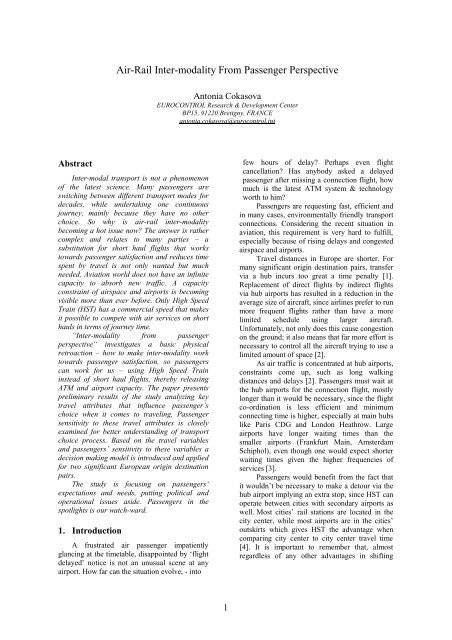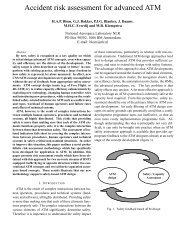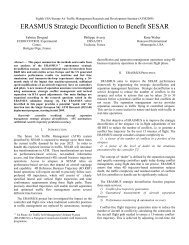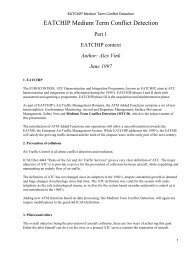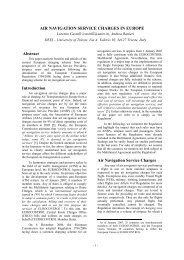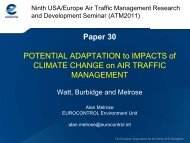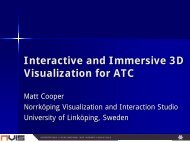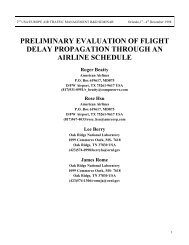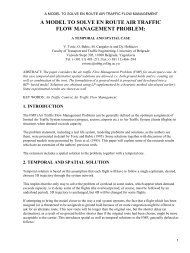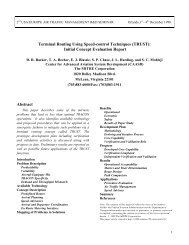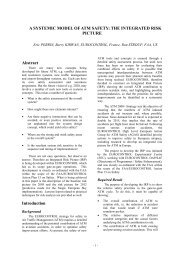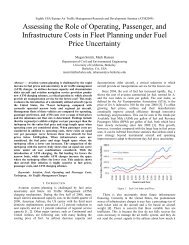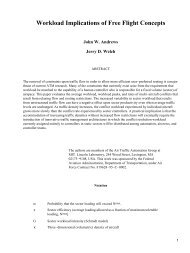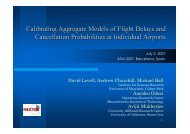Air-Rail Inter-modality From Passenger Perspective - ATM Seminar
Air-Rail Inter-modality From Passenger Perspective - ATM Seminar
Air-Rail Inter-modality From Passenger Perspective - ATM Seminar
You also want an ePaper? Increase the reach of your titles
YUMPU automatically turns print PDFs into web optimized ePapers that Google loves.
<strong>Air</strong>-<strong>Rail</strong> <strong>Inter</strong>-<strong>modality</strong> <strong>From</strong> <strong>Passenger</strong> <strong>Perspective</strong>Antonia CokasovaEUROCONTROL Research & Development CenterBP15, 91220 Bretigny, FRANCEantonia.cokasova@eurocontrol.intAbstract<strong>Inter</strong>-modal transport is not a phenomenonof the latest science. Many passengers areswitching between different transport modes fordecades, while undertaking one continuousjourney, mainly because they have no otherchoice. So why is air-rail inter-<strong>modality</strong>becoming a hot issue now? The answer is rathercomplex and relates to many parties – asubstitution for short haul flights that workstowards passenger satisfaction and reduces timespent by travel is not only wanted but muchneeded. Aviation world does not have an infinitecapacity to absorb new traffic. A capacityconstraint of airspace and airports is becomingvisible more than ever before. Only High SpeedTrain (HST) has a commercial speed that makesit possible to compete with air services on shorthauls in terms of journey time.“<strong>Inter</strong>-<strong>modality</strong> from passengerperspective“ investigates a basic physicalretroaction – how to make inter-<strong>modality</strong> worktowards passenger satisfaction, so passengerscan work for us – using High Speed Traininstead of short haul flights, thereby releasing<strong>ATM</strong> and airport capacity. The paper presentspreliminary results of the study analyzing keytravel attributes that influence passenger’schoice when it comes to traveling, <strong>Passenger</strong>sensitivity to these travel attributes is closelyexamined for better understanding of transportchoice process. Based on the travel variablesand passengers’ sensitivity to these variables adecision making model is introduced and appliedfor two significant European origin destinationpairs.The study is focusing on passengers‘expectations and needs, putting political andoperational issues aside. <strong>Passenger</strong>s in thespotlights is our watch-ward.1. IntroductionA frustrated air passenger impatientlyglancing at the timetable, disappointed by ‘flightdelayed’ notice is not an unusual scene at anyairport. How far can the situation evolve, - intofew hours of delay? Perhaps even flightcancellation? Has anybody asked a delayedpassenger after missing a connection flight, howmuch is the latest <strong>ATM</strong> system & technologyworth to him?<strong>Passenger</strong>s are requesting fast, efficient andin many cases, environmentally friendly transportconnections. Considering the recent situation inaviation, this requirement is very hard to fulfill,especially because of rising delays and congestedairspace and airports.Travel distances in Europe are shorter. Formany significant origin destination pairs, transfervia a hub incurs too great a time penalty [1].Replacement of direct flights by indirect flightsvia hub airports has resulted in a reduction in theaverage size of aircraft, since airlines prefer to runmore frequent flights rather than have a morelimited schedule using larger aircraft.Unfortunately, not only does this cause congestionon the ground; it also means that far more effort isnecessary to control all the aircraft trying to use alimited amount of space [2].As air traffic is concentrated at hub airports,constraints come up, such as long walkingdistances and delays [2]. <strong>Passenger</strong>s must wait atthe hub airports for the connection flight, mostlylonger than it would be necessary, since the flightco-ordination is less efficient and minimumconnecting time is higher, especially at main hubslike Paris CDG and London Heathrow. Largeairports have longer waiting times than thesmaller airports (Frankfurt Main, AmsterdamSchiphol), even though one would expect shorterwaiting times given the higher frequencies ofservices [3].<strong>Passenger</strong>s would benefit from the fact thatit wouldn’t be necessary to make a detour via thehub airport implying an extra stop, since HST canoperate between cities with secondary airports aswell. Most cities’ rail stations are located in thecity center, while most airports are in the cities’outskirts which gives HST the advantage whencomparing city center to city center travel time[4]. It is important to remember that, almostregardless of any other advantages in shifting1
traffic from air to rail, it is the travel time featurethat would determine the scale of any likely shift.In the case of air travel passengers spend at least3 hours by traveling to the airport, walking andwaiting at the airport. Traveling by rail the timespent reduces to 1 hour 10 min. Even if the timespent on train is much longer than the time spentin the air, under a certain distance the totaljourney time is shorter if the journey isundertaken by rail. The time spent by eachtransport mode and the average speed of eachmode indicates that high-speed trains couldreplace flights of up to 750 km’s.One might think there is not much todiscuss, transport choices are given, distancelimits are set, following the logic passengers willchoose the fastest transport, - a hasty conclusionbuild on rationale of time saving. But there ismuch more to a journey than a simple equationof time, distance and speed. There is baggage tobe transferred, tickets to be exchanged, quality ofinterconnection points, there is passengercomfort and many other factors, becomingcrucial when it comes to traveling.2. Distance and time limitThe question arising is up to what distancecan high-speed train be considered as an efficientsubstitution to short haul flights? Most studiestalk about distance between 500-800 km’s[1][4][5][6][7], very much depending onpassengers’ sensitivity to different travel factors.But what if we are not familiar with the demandmarket, we don’t know what kind of passengerswe are dealing with, neither what are their needsand priorities.<strong>Passenger</strong>s traveling by air have to considerfixed time blocks, respecting their duration,mostly set by air transport. One of the majordisadvantages of air transport to rail is the checkintime, asking the passengers to be at the airportmuch sooner before the actual flight. In general,it is one hour for economy travelers and about 40min for business travelers, depending on theamount of luggage as well.<strong>Passenger</strong> has to consider the time spent toreach the airport, which is in many casessignificantly longer than reaching a train station.<strong>Air</strong>ports are moving further and further from thecities they serve, reflecting that airports are notgood neighbors, with noise and pollution beingamong the problems. But the move brings moreproblems – notably that of access. Differentcities have different public transport and roadnetworks. The time needed to reach an airportcan be anywhere between 40 to 120 min inextreme cases (Paris CDG). In the case whereroad access is being used, this lack ofpredictability means that passengers generallyhave to plan for the ‘worst-case’ often leading toexcessive waiting time in the airport prior todeparture. On the other hand, for rail transport, acity center with rail station can typically bereached within 30 to 90 min at the most.Another fixed block to be respected bypassengers is the time necessary to unload thebaggage after landing, also the time required forpassport check & customs, which will never beless than 20 minutes and in some cases,considerably more.It is interesting to see the duration of“wasted” time at the airport or station. Thefollowing graphic shows the total “wasted” timewhen traveling, although it is not applicable inall cases.Figure 1. Travel time by air50 min ... Transport to <strong>Air</strong>port60 min ... Time spent at the <strong>Air</strong>port (check-in,boarding)??? ... Flight time is variable20 min ... Awaiting for the baggage, customs +passport check50 min ... Transport from <strong>Air</strong>portThe total time “wasted” when traveling by air isat least 3 hours. Considering that 50 minutes fortransport to/from the airport is a very optimisticestimation, for the most cases the number is evenhigher, especially for public transport.Figure 2. Travel time by rail30 min ... Transport to Station (town center)10 min ... Time spent at the Station (check-in,boarding)??? ... Travel time is variable30 min ... Transport from StationThe amount of time “wasted” whentraveling by rail is about 70 minutes. As already2
mentioned this estimation can vary depending onmany factors, does the passenger have a baggageto check-in, how far is he living from the airport,is the flight domestic or international and so on.Traveling by air the passenger can waste up to200 min, and by rail transport up to 110 minShort CheckinNo Baggage30 + 10 minShort CheckinBaggage30 + 20 minLongerCheck-inNo Baggage40 + 10 minLongerCheck-inBaggage40 + 20 minLong CheckinNo Baggage60 + 10 minLong CheckinBaggage60 +20 minSuburb40 min80min90min90min100min110min120minCenter80 min120min130min130min140min150min160minDistant120min160min170min170min180min190min200minFigure 3. <strong>Air</strong> Transport - Check-in and traveltime to airportShort Checkin10 minLong Checkin20 minSuburb30 min40min50minCenter60 min70min80minDistant90 min100min110minFigure 4. <strong>Rail</strong> Transport – Check-in andtravel time to stationExamples show that HST competes with airservices on 300-600 km distance. Thebreakdown of rail passengers decreases asdistance growth.Figure 5. <strong>Air</strong>/rail modal split [8]To answer the question about the efficienttime/distance substitution we need to set anaverage plane/train speed.<strong>Air</strong>craft speed = 800 km/hourTrain speed = 270 km/hourdistance 750 km“Wasted time” + Journey time= Total time traveledby air: 180 min + 56 min = 236 min= 3 hours 56 minby train: 70 min + 166 min = 236 minAccording to simple equation, 56 min offlight time is the upper limit, any flight underthis time limit will last longer by plane than bytrain. If aircraft flying less than 56 min isreplaced by train, the total time traveled will beexactly the same. In terms of distance the limit is750 km’s. Any distance traveled under 750 km’shas a shorter duration if traveled by train.Although this distance is considered to be ashort-haul in the aviation business, in Europe thecatchment’s area of 750 km’s can connectsignificant origin destination pairs.3. <strong>Passenger</strong>s’ expectationsEven if demand is met and services areprovided to all the passengers, service provideddoes not necessary mean quality serviceprovided. <strong>Passenger</strong>s deserve more attention.Most of the air traffic actors have no exactknowledge of passengers’ expectations andneeds.AENA’s Barcelona <strong>Air</strong>port Planning Grouphas conducted a study based on passenger needs3
[9]. The purpose of the study was to understanddelay expectations of passengers and theirperception of delay. According to interviewsundertaken with passengers punctuality is thekey substitute. Surprisingly passengers tend toaccept delay well if they are informed andupdated in advance. Arrival delay is quoted to be20% more important to the passengers thandeparture delay. Final results have shown thatpassengers’ expectations are higher thanassumed by industry managers.Even if the HST infrastructure is sufficientin many parts of Europe (there are 3039 km’s ofhigh-speed lines in operation, if constructionscontinue as projected by 2020 there will be up to10 000 km’s of high-speed and upgraded lines inEurope)[8] it is difficult to predict the number ofpassengers that would prefer rail transport to airtransport. <strong>Passenger</strong>s’ choice is influenced bymany variables. Most of the time there is noindication about passenger choice, there is nosimple rule or equation according to whichpassengers behave when choosing between twotransport modes.The best person to ask before creating adecision making model is a simple passenger,with travel experience, both good and bad.Different passengers have different sensitivityscale to various travel variables. History showsthat many times travel attributes areoverestimated (railway operators lost capacitybecause of adding too many dinning coaches,utility of coaches was much smaller thanexpected) or on the contrary underestimated(unsatisfactory baggage handling and lack ofbrand identity forced Lufthansa Express todiscontinue its service). Findings can besurprising even contradictory, just as manywould be surprised to know that the patent forMaglev HST technology writes its history since1934.No matter how sophisticated the system canget, it will hardly reach the desired success if notserving the passengers. Having sound knowledgeof passenger feedback is the first step towardswell-organized and satisfactory inter-modalconnection and interchange node with efficientbaggage handling logistics and integratedticketing, a foundation for successful air-railinter-<strong>modality</strong>.3.1 <strong>Passenger</strong>s’ sensitivity – fix parametersVariables influencing transport choice couldbe grouped into three main categories.Time – time is more important to travelerthan distance. <strong>Passenger</strong>s’ sensitivity to thisfactor varies mainly according to the purpose ofthe travel and importance of the travel. Businesstravelers tend to be more sensitive to time thaneconomy travelers. In terms of time there are twomain parts not to be neglected - time traveled tothe airport or rail station and time spent at theairport or station before the actual journey. Allthese factors are very important to passengersand could be decisive in case of transport choice.Expenses – money still talks. No need tomention that most passengers still look for theleast expensive flight ticket, than try to adjusttheir need prior to price. The target group at thistime are leisure travelers. Business travelers arerather ignorant to this variable, although thelatest figures show that business travelers,especially the individual business travelers (froma small company or working for himself/herself)are becoming extremely cost sensitive on veryshort haul flights and switching to low costcarriers. To calculate total expenses spent on thejourney we should also consider expenses for thetransport to/from the airport or station.Attractiveness and quality – is a variablegaining significantly more attention, especiallyin Western European countries and US. We needto mention few detailed examples, such aspassenger comfort, punctuality, influence fromother transport mode, frequency, attractivenessof arrival and departure time and dependency oftransport mode from weather conditions.Variables describing passenger comfort can addup to a never-ending list of attributes. Among themost important are catering services, luggagehandling, possibility to work on-board using laptopor talking on cellular phone, advantages frommile acquisition, possibility to order taxi fromboard, magazines and different kinds ofentertainment. Travelers seek quality transportmore then ever before. Quality standard set byair transport is relatively high, however railtransport has bigger potential to reach the samelevel of comfort due to its many advantages.Looking for the breakdown between air/railmode there are many variables and differences tobe taken into account. One of the main differenceis the purpose of the travel. As mentioned beforepassengers have different preferences whentraveling business or leisure. Preferences varywhen traveling in the morning or late night.The passenger market share of each modedepends on the passengers’ sensitivity todifferent travel attributes, such as cost (journeycost, cost to and from the airport/station), time(journey time, time to and from theairport/station, walking/waiting time) and4
attractiveness (frequency, competition, on-boardservices). These attributes, and especiallypassengers’ sensitivity to them, will beinvestigated closely.3.2 QuestionnaireA questionnaire was undertaken in order tostudy the sensitivity of passengers to eightdifferent travel factors (ticket price, price to/fromairport/station, travel time, time to/fromairport/station, walking/waiting time, frequency,competition, on-board services). Around 50participants who answered the questionnairewere from EUROCONTROL ERC, 20international students and 30 French citizens,different age and sex. The questionnaire wasundertaken in May and June 2002. Participantswere asked to assign an importance to eachtravel attribute, while traveling both way -economy and leisure. On a 10-point scale theresults were the following. The higher thenumber the more sensitive passengers are to acertain factor.Figure 6. <strong>Passenger</strong>s’ sensitivity to travelattributesAntonia Cokasova – May/June 2002According to the questionnaire passengersflying for leisure travel are most sensitive toticket price and the least sensitive to on-boardservices. Business travelers are the mostsensitive to journey time and the least sensitiveto price to and from airport or station. Thisquestionnaire covers a very specific group ofpeople, there is a high geographical sensitivity. Itwould be interesting to see the results if theparticipants were from different workingenvironment and from different part of the world(Eastern Europe or US). The results would mostlikely vary in Germany, since the population isvery time sensitive, much more than in France.Since participants were mostly from France,when implementing passengers’ sensitivity in thedemand distribution model, it was better toconsider origin destination pairs relating to aFrench destination, - Paris.4. Demand distribution model4.1 Travel factors - variable parametersAfter the parameters influencing passengertransport choice were specified, it was necessaryto describe the parameters and assign a value toeach of them, in order to implement them intothe demand model. The model consist of fix andvariable parameters. Fix parameters wereintroduced above as passengers’ sensitivity totravel attributes.Value - all the factors used in demandmodel vary on 10-point scale in order to allowthe same importance to each factor. Variablefactors considered for the demand distributionmodel are the following:‰ Journey CostFlight cost (AIR) – it is difficult to consider thecost in money value, we need to have a commonattribute suitable for different short haul flights.The classification used in the IATA APT Rules(<strong>Air</strong> <strong>Passenger</strong> Tariff) offers ticket categories,according to which different ticket types couldbe graded. Since we are only interested in shorthaul flights, mostly provided by medium sizeaircraft with no first class seats, 7 different ticketclassification are available (including low costfare). In the model the ticket classification has avalue on a 10-point scale, starting Low cost farewith the value 2.5 going up to Business ClassPremium air fare with value 9,5.J - Business Class Premium 9,5C - Business Class 9,0D - Business Class Discounted 8,5W - Economy/Coach Premium 6,0S - Economy/Coach 5,5BHKLMNQTVX - Economy/CoachDiscounted 5,0The number of passengers choosing low costcarriers is rising all over Europe, It is importantto add the 7 th ticket classification. The ticketprice is in most of the cases comparable withtrain fares.Low cost fare 2,55
There is a value jump between economy andbusiness fares, since the prices of the businesstickets are often almost the double of economy,both for air and rail mode.Journey cost (RAIL) – the variety of the tickettypes is smaller than in air transport. Althoughsome railway companies are setting their faresusing methods akin to the airlines’ yieldmanagement policy; for example Thalys hasalready 7 ticket classes. To cover most of therailways we consider only the major classes,since not all railways practice the same pricingpolicy as Thalys.Business Class 1 / Class 1 5,0Business Class Discounted 4,5Economy Class / Class 2 2,5Economy Class / Discounted StudentFare 2,0‰ Cost to/from airport/stationthe factor depends on the location of the airportor station (distance from the departure point ofthe passenger) and on the means of transport(public transportation/own car/taxi). The bestcomparison is made by converting the cost toEURO per km. There is no differentiationbetween air or rail travelers.This variable is also between 1 and 10. The costshould not exceed 5 Euro/km.Price Value Price Value0.5 Euro/km 1 3 Euro /km 61 Euro/km 2 3.5 Euro/km 71.5 Euro/km 3 4 Euro/km 82 Euro/km 4 4.5 Euro/km 92.5 Euro/km 5 5 Euro/km 10‰ TimeAll the factors concerning travel time (flighttime, time to/from airport/station, andwalking/waiting time) are applied in hours.‰ CompetitivenessThis corresponds to the influence in the decisionmaking process from different types ofplane/train or other mode of transport. In a twohourslot how many other planes/trains leavefrom the same airport or station with the samedestination? The highest number of planes/trainsdeparting from the same station we consideredwas 10. If there is one train/plane leaving in 2hour slot from the same station/airport the valuein the demand model is one, if there are 5trains/planes the value is 5.‰ FrequencyThe value represents the number of planes/trainsdeparting from the same airport/station with thesame destination in a 24-hour period. To preventoverestimation it is essential to normalize thefinal number so as to remain on a 10-point scale.The highest frequency we have considered was20 planes/trains in a 24-hour period. Each factorwill be divided by 2.‰ On-board servicesThis factor is a group of services such as cateringservices, luggage handling, possibility to workon-board using lap-top or talking on cellularphone, advantages from mile acquisition,possibility to order taxi from board, magazinesand different kinds of entertainment. The factorhas a value from 0 to 10, according to theservices provided. There are 10 different classesof air and rail tickets all together, in this case it’seasy to assign a value from 1 to 10.4.2 Seat ratioThe difference in number of economy andbusiness seats must not be overlooked whencomparing the breakdown. Most of the aircraftflying on short-haul distances that could bereplaced by HST services carry on-board 93% ofeconomy and only 7% business passengers. Thisseat ratio is an average number of examinedaircraft types:A 320 12 Business/138 EconomyA 319 8 Business/116 EconomyB 737-300 8 Business/118 EconomyB737-600 8 Business/102 EconomyB737-700 8 Business/118 EconomyB 737-500 8 Business/102 EconomyThe situation is different for trains. HSTcarry 60% economy and as much as 40%business passengers.Since the difference between plane and trainis significant, the seat ratio was taken intoconsideration in the demand model.4.3 Demand equationOnce the travel factors and passengers’sensitivity were observed, the transport demandmodel or utility, was completed. The demandmodel of a certain transport mode has thefollowing form: C is a total cost, T is total timeand S is attractiveness and quality.D = C + T + SThe first two factors, cost and time, havenegative values, the smaller the value the better6
for the passenger. The total cost can be describedas a sum of journey cost from departure “i” todestination “a” (C ia ) multiplied by passengers’sensitivity to journey cost (θ), and cost to/fromairport/station (O ia ) multiplied by passengers’sensitivity to cost to/from airport or station (ε).C = - [θ C ia + ε O ia ]The total time is described as the sum ofjourney time (T ia ) multiplied by passengers’sensitivity to journey time (α)Ã WLPHÃ WRIURPÃairport/station (A ia ) multiplied by passengers’sensitivity to time to/from airport or station(γ), DQGÃZDONLQJZDLWLQJÃWLPHÃ: ia ) multiplied bywalk/wait time sensitivity (δ)Ã )DFWRUVÃ KDYHÃnegative value for the same reason as describedbefore.T = - [α T ia + γ A ia + δ W ia ]Attractiveness and quality is the sum offrequency (H ia ) multiplied by passengers’sensitivity to frequency (β), competitiveness (P ia )multiplied by passengers’ sensitivity tocompetitiveness (λ), and on-board services (S ia )multiplied by passengers’ sensitivity to on-boardservices (µ). Attractiveness is the only attributewith a positive value, since the higher the qualitythe better from the passenger point of view.S = β H ia + λ P ia + µ S iaAfter comparing each factor separately theresult shows a percentage of passengers choosingthe examined transport mode. The form ofequation is such that the model will alwaysforecast passenger distribution between 0% and100%.4.5 Practical examplesOnce all the variables are introduced, theycan be applied to practical examples and realsituations. As mentioned before it is better tochoose a flight from Paris, since the examinedgroup of people were mostly French.Paris – LondonAccording to airport statistics, this was the2 nd busiest route in Europe in the last few years,supporting 2,92 million passengers each year[10]. <strong>Passenger</strong> numbers changed following theintroduction of the new Eurostar high-speedtrain passing through Channel Tunnel. It is oneof the few OD pairs where HST and air cansimultaneously be considered as viable traveloptions.The following example is a simple travelmodel from Paris to London by air created tosimulate our decision making model. There is amix of economy passengers (73%, see seat ratiochapter) with economy/coach tickets andbusiness travelers (7%) with business tickets.Economy passengers are taking the train to theairport with the average cost of 1 Euro/km,business travelers are taking a taxi, costing 2Euro/km. The flight time is 72 min and there aretwo trains leaving from the same airport in a 2-hour slot with the same destination. The time toget to and from the airport is 54 minutes. All ofthe travelers have to walk and wait at least 1hour at the airport. Business travelers have muchbetter pre-boarding and on-board services thaneconomy. The frequency of aircraft is once every2 hours.For rail we also have a mix of economy andbusiness passengers (60% economy and 40%business, see seat ratio chapter) withcorresponding tickets. The other attributesremain the same, except for the travel time,which is 3 hours and the time to/from A/P orstation, also the walk/wait time, which is 18 minfor each.Traveling by AIR:Economy BusinessC - Flight cost 5,5 8,5O - Cost to/from A/P-S 1,0 2,0T - Flight time 1,2 1,2H - Frequency 2,0 2,0A - Time to/from A/P-S 0,9 0,9W - Walk/wait time 1,0 1,0P - Competitiveness 2,0 2,0S - On-board services 4,0 8,0Traveling by RAIL:Economy BusinessC - Flight cost 2,5 5,0O - Cost to/from A/P-S 1,0 2,0T - Flight time 3,0 3,0H - Frequency 4,0 4,0A - Time to/from A/P-S 0,3 0,3W - Walk/wait time 0,3 0,3P - Competitiveness 1,0 1,0S - On-board services 3,0 6,0<strong>Passenger</strong> Sensitivity:Economy Business(θ) - Flight cost 7.53 3.56(ε) - Cost to/from A/P 4.92 3.13(α) - Flight time 5.81 7.73(β) - Frequency 5.54 6.36(γ) - Time to/from A/P 6.92 7.21(δ) - Walk/wait time 6.34 7.02(λ) - Competitiveness 5.20 4.08(µ) - On-board services 4.54 5.987
Implementing the values above into the demandequation the percentage of passengers choosingair transport is 43% and passengers prefer railadd up to 57%. This breakdown changes whenany factor input changes.Paris – BrusselsThis was one of the busiest air routes priorto the introduction of the Thalys. Recently, highspeedtrain has replaced all the flights, sincepassengers had realized the time saving. Underthe terms of agreement, <strong>Air</strong> France replaced itsflights with chartered Thalys coaches betweenBrussels-Midi and Roissy-Charles De Gaulle andshowed willingness to go in this direction ratherthan trying to compete directly. But it was alsofeasible because of the rail link being at CDG.Without this, it might not have happened.In order to compare the air and railbreakdown we suppose that there are still flightsbetween Paris and Brussels without a stopover.The flight time is 50 min, and the train journeytakes 1h20. For ease of comparison, all the otherattributes (walk/wait time, cost to/fromairport/station, etc.) remain the same. Thedemand equation results in 34% for air transportand 66% for rail transport. In reality, it isimpossible to measure, since as alreadymentioned the high-speed train is the onlytransport option.According to these results, aviation shouldcapture 34% of the passenger traffic. We canconclude that even if there is 34% of air share, itis not enough to keep the air market alive, sinceairlines stopped operating on this route. Ofcourse reasons could have been various.Other destinationsIt is interesting to compare the value forbreakdown between the European mostconstrained routes. According the CAA airportstatistics and ICAO data, the routes supportingthe largest traffic in passenger km’s for last fewyears were the following.1 London-Dublin 11 London-Munich2 London-Paris 12 London-Geneva3 London-Amsterdam 13 Copenhagen-Oslo4 London-Frankfurt 14 Paris-Milan5 London-Zurich 15 Paris-Madrid6 London-Rome 16London-Dusseldorf7 London-Milan 17 Paris-Frankfurt8 London-Madrid 18London-Stockholm9 London-Copenhagen 19 Copenhagen-Stock10 Paris-Rome 20 Paris-AmsterdamOut of the 20 busiest routes in Europe, 9 areabove 1000 km, 3 routes are between 800-900km and 8 are less then 800 km. In theory highspeedtrain can replace 40% of the 20 busiestroutes. For less time sensitive passengers thepercentage rises to 55%.<strong>Inter</strong>-<strong>modality</strong> with rail will producesignificant capacity gains by transformingcompetition between rail and air intocomplementary between the two modes, withhigh-speed train connections between cities. Wecan no longer think of maintaining air links todestinations for where there is a competitivehigh-speed rail alternative. In this way, capacitycould be transferred to routes where no highspeedrail services exist. More efficient, morerational use of airports will not obviate the needfor increase in capacity. The fact is that newairport projects are few in number (Lisbon,Berlin, Paris).5. ConclusionPreliminary results obtained seem to open anew spectrum of questions. As mentionedbefore it would be interesting to see a differentmix of participants as well as a differentquestionnaire asking passengers to rank theirpriorities instead of assigning an importance toeach attribute. At the moment more attention isgiven to true air-rail co-operation (plane-train,train-plane) rather than surveying each modeseparately, following the door-to-door transportscheme. Up-to-date results slightly vary frompreliminary results, mainly because the averagespeed of both transport modes was overestimatedin the beginning. Study continues on the decisionmaking model, also the parameters influencingdecision making are observed in a more detailedway. Another questionnaire is foreseen, at thistime focusing on passengers passing throughinter-modal terminals (Paris CDG, FrankfurtMain, Oslo Gardemoen, Lyon Satolas, Zurich<strong>Air</strong>port, Brussels <strong>Inter</strong>national). <strong>Passenger</strong>sgiven the choice to travel both modes will be ourmain source of information. Another survey isplanned, examining passengers at travel agenciesin order to gain a better knowledge ofpassengers’ trade off between various travelfactors. Having passengers feedback and soundknowledge of their expectations will help toidentify the reduction in air transport demand.The era of transport rivalry mustbecome a thing of the past. If mobility is to besafeguarded in the long term, the modes willhave to work together. In the long term,intelligent division of labor is indispensable,each mode covering that part of the transportchain for which it is best suited.8
Reference[1] Widmer, J.P. & Axhausen, K.W. (2001)Institute fur Verkehrsplanung, Transporttechnik,Strassenund Eisenbahnbau. Do rail stations atairports allow a better distribution of passengerdemand among airports? (Presentation paper),ETH Zurich, January 2001, Washington D.C.BiographiesAntonia Cokasova is a PhD student in TheInnovative Research Business Area at theEUROCONTROL Experimental Center. Sheholds a Master Degree in Civil AviationEngineering from University of Transport inZilina ( Slovakia).[2] European Transport Policy 2001,Controlling the growth in air transport[3] Rietveld, P. & Brons, M. (2001).Quality of hub-and-spoke networks; the effects oftimetable co-ordination on waiting time andrescheduling time. Journal of <strong>Air</strong> TransportManagement 7 (2001), p. 241-249[4] Givoni, M. (2001). <strong>Air</strong>line and railwayco-operation, a new approach to inter<strong>modality</strong> –a research perspective. April 2001, UniversityCollege of London, London[5] Moore, P. (2001). High speed rail as asolution to airport congestion. Sierra Club –Loma Prieta Transportation Committee,California[6] European Commission - European Cooperationin the field of Scientific and TechnicalResearch (1996). Cost 308. <strong>Inter</strong>action betweenHigh Speed and <strong>Air</strong> passenger Transport. April1996, Brussels[7] Ellwanger, G. (2002). Successes forhigh speed rail. <strong>Rail</strong> international. UIC,September 2002, Brussels[8] All about HS, Definition of High SpeedTrain (2002), http://www.uic.asso.fr[9] AENA (2002). Analyses of <strong>Passenger</strong>sDelays at Barcelona <strong>Air</strong>port, October 2002[10] Fresneau, X. (2000). Generic serviceson capacity constrained routes, Final thesis,University of Westminster, LondonKeywords<strong>Inter</strong>-<strong>modality</strong>, air-rail, high-speed train, airtransport demand reduction, passengersensitivity, demand distribution model, transportmodal split, travel attributes, fix and variableparameters, questionnaire.9


